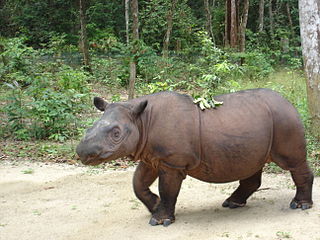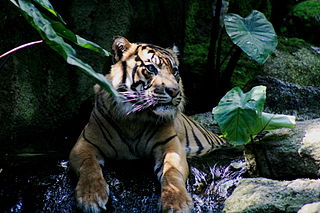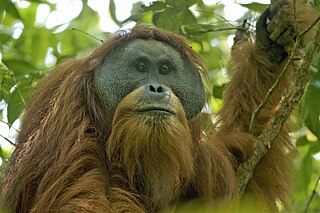
Gorillas are herbivorous, predominantly ground-dwelling great apes that inhabit the tropical forests of equatorial Africa. The genus Gorilla is divided into two species: the eastern gorilla and the western gorilla, and either four or five subspecies. The DNA of gorillas is highly similar to that of humans, from 95 to 99% depending on what is included, and they are the next closest living relatives to humans after chimpanzees.

Orangutans are great apes native to the rainforests of Indonesia and Malaysia. They are now found only in parts of Borneo and Sumatra, but during the Pleistocene they ranged throughout Southeast Asia and South China. Classified in the genus Pongo, orangutans were originally considered to be one species. From 1996, they were divided into two species: the Bornean orangutan and the Sumatran orangutan. A third species, the Tapanuli orangutan, was identified definitively in 2017. The orangutans are the only surviving species of the subfamily Ponginae, which diverged genetically from the other hominids between 19.3 and 15.7 million years ago.

Apes are a clade of Old World simians native to sub-Saharan Africa and Southeast Asia, which together with its sister group Cercopithecidae form the catarrhine clade, cladistically making them monkeys. Apes do not have tails due to a mutation of the TBXT gene. In traditional and non-scientific use, the term ape can include tailless primates taxonomically considered Cercopithecidae, and is thus not equivalent to the scientific taxon Hominoidea. There are two extant branches of the superfamily Hominoidea: the gibbons, or lesser apes; and the hominids, or great apes.

Twycross Zoo is a medium to large zoo near Norton Juxta Twycross, Leicestershire. The zoo has the largest collection of monkeys and apes in the Western World, and in 2006 re-launched itself as "Twycross Zoo – The World Primate Centre".

The Sumatran rhinoceros, also known as the Sumatran rhino, hairy rhinoceros or Asian two-horned rhinoceros, is a rare member of the family Rhinocerotidae and one of five extant species of rhinoceros; it is the only extant species of the genus Dicerorhinus. It is the smallest rhinoceros, although it is still a large mammal; it stands 112–145 cm (44–57 in) high at the shoulder, with a head-and-body length of 2.36–3.18 m and a tail of 35–70 cm (14–28 in). The weight is reported to range from 500–1,000 kg (1,100–2,200 lb), averaging 700–800 kg (1,540–1,760 lb). Like both African species, it has two horns; the larger is the nasal horn, typically 15–25 cm (5.9–9.8 in), while the other horn is typically a stub. A coat of reddish-brown hair covers most of the Sumatran rhino's body.

Ponginae, also known as the Asian hominids, is a subfamily in the family Hominidae. Once a diverse lineage of Eurasian apes, the subfamily has only one extant genus, Pongo (orangutans), which contains three extant species; the Sumatran orangutan, the Tapanuli orangutan and the Bornean orangutan. All three species are listed as critically endangered by the International Union for Conservation of Nature (IUCN).

A felid hybrid is any of a number of hybrids between various species of the cat family, Felidae. This article deals with hybrids between the species of the subfamily Felinae.

Captive breeding, also known as captive propagation, is the process of keeping plants or animals in controlled environments, such as wildlife reserves, zoos, botanic gardens, and other conservation facilities. It is sometimes employed to help species that are being threatened by the effects of human activities such as climate change, habitat loss, fragmentation, overhunting or fishing, pollution, predation, disease, and parasitism.

The Sumatran orangutan is one of the three species of orangutans. Critically endangered, and found only in the north of the Indonesian island of Sumatra, it is rarer than the Bornean orangutan but more common than the recently identified Tapanuli orangutan, also found in Sumatra. Its common name is based on two separate local words, orang 'people; person' and hutan 'forest', derived from Malay, and translates as 'person of the forest'.

The Bornean orangutan is a species of orangutan endemic to the island of Borneo. Together with the Sumatran orangutan and Tapanuli orangutan, it belongs to the only genus of great apes native to Asia. It is the largest of the three species of orangutans. Like the other great apes, orangutans are highly intelligent, displaying tool use and distinct cultural patterns in the wild. Orangutans share approximately 97% of their DNA with humans. Also called mias by the local population, the Bornean orangutan is a critically endangered species, with deforestation, palm oil plantations, and hunting posing a serious threat to its continued existence.

The fauna of Indonesia is characterised by high levels of biodiversity and endemicity due to its distribution over a vast tropical archipelago. Indonesia divides into two ecological regions; western Indonesia which is more influenced by Asian fauna, and the east which is more influenced by Australasian species.
Orangutans have often attracted attention in popular culture. They are mentioned extensively in works of fiction and video games, while some captive individuals have drawn much attention in real life.

The Hominidae, whose members are known as the great apes or hominids, are a taxonomic family of primates that includes eight extant species in four genera: Pongo ; Gorilla ; Pan ; and Homo, of which only modern humans remain.
The Sumatran Orangutan Conservation Programme (SOCP) is a collaborative project involving Indonesian NGO Yayasan Ekosistem Lestari (YEL) - as the main implementer in Indonesia, its Swiss partner the PanEco Foundation, and the Indonesian Ministry of Environment and Forestry’s Directorate General of Natural Resource and Ecosystem Conservation, under several Memoranda of Understanding (MoU) starting in 1999.

The Tapanuli orangutan is a species of orangutan restricted to South Tapanuli in the island of Sumatra in Indonesia. It is one of three known species of orangutan, alongside the Sumatran orangutan, found farther northwest on the island, and the Bornean orangutan. It was described as a distinct species in 2017. As of 2018, there are roughly 800 individuals of this species and it is currently on the critically endangered species list.
Batang Toru hydropowerplant is an under construction hydropower plant project located in Batang Toru River in South Tapanuli District of North Sumatra Province in Indonesia. The power plant is scheduled to be operational in 2022 and designed to be 4x127.5 MW in capacity. Batang Toru hydropower plant is developed by PT North Sumatra Hydro Energy, a company founded in 2008. The pre-construction phase of the power plant has been started after the Purchasing Power Agreement (PPA) contract with the National Electricity Company (PLN) was signed on December 21, 2015.

There are three species of orangutan. The Bornean orangutan, the most common, can be found in Kalimantan, Indonesia and Sarawak and Sabah in Malaysia. The Sumatran orangutan and the Tapanuli orangutan are both only found in Sumatra, Indonesia. The conservation status of all three of these species is critically endangered, according to the International Union for Conservation of Nature (IUCN) Red List.













